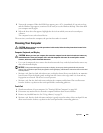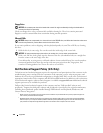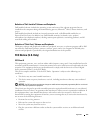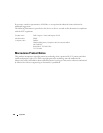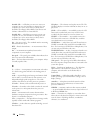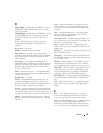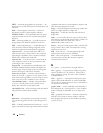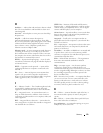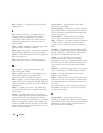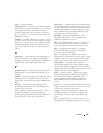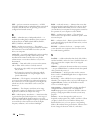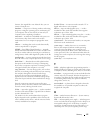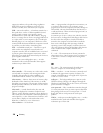
Glossary 171
D
DDR SDRAM — double-data-rate SDRAM — A type of
SDRAM that doubles the data burst cycle, improving
system performance.
DDR2 SDRAM — double-data-rate 2 SDRAM — A type
of DDR SDRAM that uses a 4-bit prefetch and other
architectural changes to boost memory speed to over
400 MHz.
device — Hardware such as a disk drive, printer, or
keyboard that is installed in or connected to your
computer.
device driver — See driver.
DIMM — Dual Inline Memory Module.
DIN connector — A round, six-pin connector that
conforms to DIN (Deutsche Industrie-Norm) standards;
it is typically used to connect PS/2 keyboard or mouse
cable connectors.
disk striping — A technique for spreading data over
multiple disk drives. Disk striping can speed up operations
that retrieve data from disk storage. Computers that use
disk striping generally allow the user to select the data
unit size or stripe width.
DMA — direct memory access — A channel that allows
certain types of data transfer between RAM and a device
to bypass the processor.
docking device — See APR.
DMTF — Distributed Management Task Force — A
consortium of hardware and software companies who
develop management standards for distributed desktop,
network, enterprise, and Internet environments.
domain — A group of computers, programs, and devices
on a network that are administered as a unit with common
rules and procedures for use by a specific group of users. A
user logs on to the domain to gain access to the resources.
DRAM — dynamic random-access memory — Memory
that stores information in integrated circuits containing
capacitors.
driver — Software that allows the operating system to
control a device such as a printer. Many devices do not
work properly if the correct driver is not installed in the
computer.
DSL — Digital Subscriber Line — A technology that
provides a constant, high-speed Internet connection
through an analog telephone line.
dual display mode — A display setting that allows you to
use a second monitor as an extension of your display. Also
referred to as extended display mode.
DVD — digital versatile disc — A high-capacity disc
usually used to store movies. DVD drives read most CD
media as well.
DVD drive — A drive that uses optical technology to read
data from DVDs and CDs.
DVD player — The software used to watch DVD movies.
The DVD player displays a window with buttons that you
use to watch a movie.
DVD-R — DVD recordable — A recordable version of a
DVD. Data can be recorded only once onto a DVD-R.
Once recorded, the data cannot be erased or written over.
DVD+RW — DVD rewritable — A rewritable version of
a DVD. Data can be written to a DVD+RW disc, and
then erased and written over (rewritten). (DVD+RW
technology is different from DVD-RW technology.)
DVD+RW drive — A drive that can read DVDs and most
CD media and write to DVD+RW (rewritable DVDs)
discs.
DVI — digital video interface — A standard for digital
transmission between a computer and a digital video
display.
E
ECC — error checking and correction — A type of
memory that includes special circuitry for testing the
accuracy of data as it passes in and out of memory.
ECP — extended capabilities port — A parallel connector
design that provides improved bidirectional data
transmission. Similar to EPP, ECP uses direct memory
access to transfer data and often improves performance.





